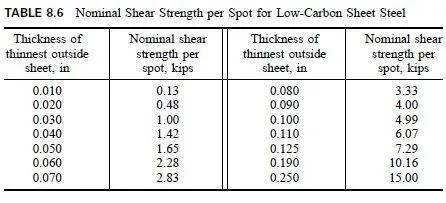Resistance welding comprises a group of welding processes wherein coalescence is produced by the heat obtained from resistance of the work to flow of electric current in a circuit of which the work is part and by the application of pressure.
Because of the size of the equipment required, resistance welding is essentially a shop process. Speed and low cost are factors favoring its selection.
Almost all resistance-welding processes require a lap-type joint. The amount of contacting overlap varies from 3â„8 to 1 in, depending on sheet thickness. Access to both sides of the joint is normally required. Adequate clearance for electrodes and welder arms must be provided.
Spot Welding
Spot welding is the most common resistance-welding process. The weld is formed at the interface between the pieces being joined and consists of a cast-steel nugget.
The nugget has a diameter about equal to that of the electrode face and should penetrate about 60 to 80% of each sheet thickness.
For structural design purposes, spot welds can be treated the same way as bolts, except that no reduction in net section due to holes need be made. Table 8.5 gives the essential information for design purposes for uncoated steel based on Recommended Practices for Resistance Welding. American Welding Society, 1966.
The maximum allowable loads per weld for design purposes are based on shear strengths of welds observed in tests after application of a safety factor of 2.5 bounds of data. Note that the thickest steel for plain spot welding is 1â„8 in. Thicker material can be resistance welded by projection or by pulsation methods if high capacity spot welders for material thicker than 1â„8 in are not available.
Projection Welding
This is a form of spot welding in which the effects of current and pressure are intensified by concentrating them in small areas of projections embossed in the sheet to be welded. Thus, satisfactory resistance welds can be made on thicker steel using spot welders ordinarily limited to thinner stocks.

Pulsation Welding
Pulsation, or multiple-impulse, welding is the making of spot welds with more than one impulse of current, a technique that makes some spot welders useful for thicker materials. The tradeoffs influencing choice between projection welding and impulse welding involve the work being produced, volume of output, and equipment available.
Recommended Practices for Spot Welding
The spot welding of higher-strength steels than those contemplated under Table 8.5 may require special welding conditions to develop the higher shear strengths of which the higher-strength steels are capable.
All steels used for spot welding should be free of scale; therefore, either hotrolled and pickled or cold-rolled steels are usually specified.
Steels containing more than 0.15% carbon are not as readily spot welded as lower-carbon steels, unless special techniques are used to ensure ductile welds.
High-carbon steels such as ASTM A653, SQ Grade 50 (formerly, A446, Grade D), which can have a carbon content as high as 0.40% by heat analysis, are not recommended for resistance welding. Designers should resort to other means of joining such steels.

Maintenance of sufficient overlaps in detailing spot-welded joints is important to ensure consistent weld strengths and minimum distortions at joints. Minimum weld spacings specified in Table 8.5 should be observed, or shunting to previously made adjacent welds may reduce the electric current to a level below that needed for welds being made. Also, the joint design should provide sufficient clearance between electrodes and work to prevent short-circuiting of current needed to make satisfactory spot welds. For further information on spot welding of coated steels, see Recommended Practices for Resistance Welding of Coated Low-Carbon Steel, American Welding Society, 550 N.W. Lejeune Rd., Miami, FL 33126.
The nominal shear strength per spot, is a function of the thickness of the thinnest outside sheet. Table 8.6 lists spot shear strengths for sheets with thicknesses from 0.010 to 0.250 in, as recommended for design by the American Iron and Steel Institute.


